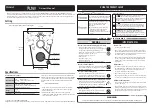
Series 8650B Universal Power Meters
2-40
Publication 31470-001, Rev C, November 2, 2017
2.4.16
Burst Dropout
In the BAP mode, average power is measured only during bursts. Because, in this mode, the bursts are
automatically detected by the power meter, the user need not be aware of the burst repetition rate in order to
make the measurement.
However, the BAP measurement algorithm defines bursts in a way which may be considered undesirable in
some applications. In the example illustrated below, a 3.5 ms burst is followed by an OFF period of the same
duration. During the burst, two brief dropouts occur. Normally, in BAP mode, each dropout would be
interpreted as the end of a burst; the BAP algorithm would interpret the burst as three separate bursts, and the
dropouts would be excluded from the average power measurement. As a result, the average power reading
would be artificially raised.
When the Burst Dropout feature is enabled, the BAP algorithm is modified so that a dropout of sufficiently brief
duration is not interpreted as the end of a burst. In the example below, dropout time is specified at 350 µs. The
two dropouts, which occur during the burst, have a duration of less than 350 µs; therefore the entire burst is
interpreted as a single burst, and the dropouts are included in the average power measurement. The 3.5 ms OFF
period following the burst is interpreted as the end of the burst, because it exceeds 350 µs in duration.
This feature must be configured and interpreted with care. The dropout time is selected from a series of discrete
values from 0.000 ms to 3.746 ms in increments of 0.027 ms when end exclude time is 0.000 ms. For non-zero
values of end exclude time, the maximum value of burst dropout time is limited to 3.423 ms minus the end
exclude setting. These are only the guaranteed minimum values. In practice, the BAP algorithm may tolerate
dropouts up to 2.15 times as long as the minimum value. Therefore, the time between bursts must be at least
2.2 times as long as the selected dropout time (If the time between bursts is less than the tolerated dropout
time, the BAP algorithm never recognizes the end of a burst, and the signal is simply averaged, as if the MAP
mode had been selected). Also, dropouts occurring at the end of a burst are a problem, because the BAP
algorithm cannot distinguish them from the end of the burst itself; there should be at least 250 µs of burst
remaining after the last dropout within that burst.
Figure 2-21: Burst Dropout
Содержание 8650B Series
Страница 3: ...Series 8650B Universal Power Meters Publication 31470 001 Rev C November 2 2017 iii ...
Страница 18: ......
Страница 32: ......
Страница 78: ......
Страница 236: ......
Страница 244: ......
Страница 258: ......
Страница 263: ...Menu Structure Publication 31470 001 Rev C November 2 2017 D 3 Figure D 3 Modulation Sensor B Setup Menu Structure ...
Страница 265: ...Menu Stucture Publication 31470 001 Rev C November 2 2017 Page D 5 Figure D 4 Meter Setup Menu Structure ...
Страница 267: ...Publication 31470 001 Rev C November 2 2017 Last page of the document ...
















































